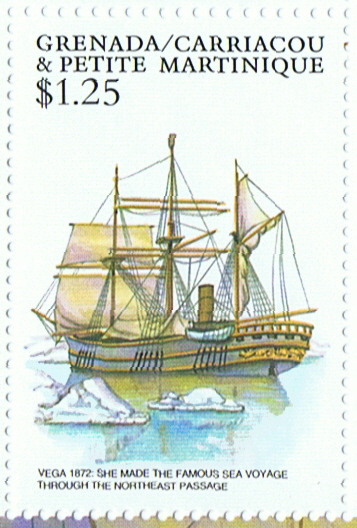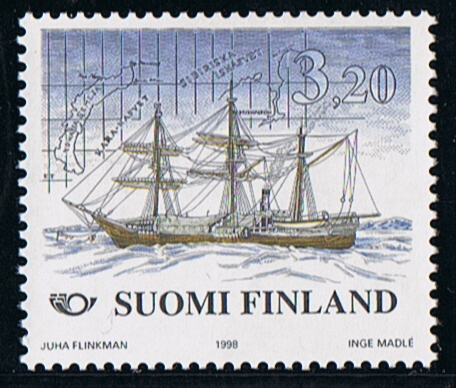

Built in 1872 by F.W. Wencke at Bremerhaven for A. Rosenthal at Bremerhaven as a sealer.
Before completing end 1872 sold to Rederi A/B Ishafret at Göteborg, Sweden.
By launching named VEGA.
Tonnage 357 gross, 299 net, dim. 43.4 x 8.4 x 4.6m., length of keel 37.6m.
Barque rigged, oaken hull on the waterline strengthened with greenheart.
Powered by a 60hp steam engine, speed on engine 6.7 knots, under sail 10 knots.
Coal consumption 10 cubic feet an hour.
After delivery used as a sealer and whaler in Arctic waters.
1877 Sold to Prof. A.E. Nordenskjöld and Associates for his expedition to push trough the North East Passage, around the northern part of Russia.
The expedition was sponsored by King Oscar Bernadotte of Sweden and Dickson a merchant (the town Dickson is named after him and Dickson Island near Novaya Zemlya) and Sibirjakov a wealthy mine owner from Siberia.
Nordenskjöld (1832-1901) had thoroughly prepared for this expedition by having taken several preliminary voyages before leaving on the VEGA.
The VEGA was fitted out for the expedition by the Swedish Navy yard in Karlskrona.
22 June 1878 the Vega left Karlskrona with on board 29 men under command of Capt. Lieutenant Louis Palander.
The VEGA sailed via Copenhagen for provision to Göteborg, for scientific equipment. Then she sailed for Tromso where Nordenskjöld boarded the vessel on 21 July together with three seal hunters.
06 August the VEGA anchored near an island (Dickson Island) were a deer and a bear were shot. The VEGA sailed then via the Taimyr Strait were the first sea-ice was seen around Cape Tseljoeskin (19 August) the most northerly cape of Asia. Never before was this cape reached by any expedition over sea.
03 September the expedition reached Bear Island and on 6 September Cape Sjelagskij were the first natives were met.
After she had passed the cape the sea quickly froze over and near Cape Irakpin the VEGA got beset in the ice only 425 mile from the Bering Strait. By some luck and changing of wind a canal in the ice was formed and the VEGA could slowly sail to Koljoetsjin Bay were the VEGA was frozen in on 27 September only two days sailing from the Bering Strait and open waters.
18 July 1879 the ice was moving and a few hours later the VEGA was free, and two days later the Bering Strait was reached. The first passage for a vessel around the north of Siberia was accomplished.
The VEGA anchored near Cape Desnjew and then sailed to Port Clarence on the American side of the strait.
Only on 19 August (other sources give 02 September) could Nordenskjöld at Yokohama inform the rest of the world that the VEGA did safely pass the North East Passage.
The VEGA sailed home via Kobe, Nagasaki, Hong Kong, Labuhan, Singapore, Ceylon, Suez, Naples, Lisbon, Falmouth, Flushing, Copenhagen to Stockholm, where she arrived on 24 July 1880 (other source gives 24 April 1880).
After the expedition the VEGA returned to Rederi A/B Ishafret
December 1901 sold to Thor Dahl at Sandefjord, Norway.
1903 Sold to R. Ferguson & Co. Dundee, Scotland.
Thereafter used as a whaler by the Dundee owner in the waters off Greenland.
31 May 1905 in the Melville Bay she was beset in the ice for seven days, then her sides crushed in and the VEGA sank so quickly that her crew had barely time to jump on the ice half-clothed and without boots or stockings. The wrecking occurred off Wilcox’s point, and the 45 men had 6½ day’s exposure in the open boats before they reached Upernivik. After staying there seven days, part of the crew in two boats set out again, hoping to intercept the Copenhagen steamer NOV.
After another boat voyage of 300 miles, they were lucky enough to find the NOV at Egedesminde. She took them aboard and eventually landed them at Aberdeen. The remainder of the crew reached Godhavn, where they were taken home by the Danish mail packet.
Of the Finland stamp of 1998 of FIM 3.20, Watercraft Philately gives:
A Swedish expedition led by the Finish born Adolf Erik Nordenskjöld, a pioneer in the northern marine research over a century ago was the first to sail the North-East Passage to the Pacific Ocean. Their ship the VEGA originally designed as a whaler, was equipped for arctic voyages with special tackle designed to withstand the long severe winter of the North-East Passage. The ships hull was reinforced throughout to endure the cruising force of the ice.
The illustration of the VEGA on the stamp was based on a unique photograph taken by Louis Palander as the vessel wintered over in Pitlekai, Siberia.
The map serving as background is a reproduction of the chart Nordenskjöld himself made of the North-East Passage. Its shows Novaya Zellya island the Kara Sea and the Arctic Ocean.
The stamp first day cover and postmark were designed by marine biologist and artist Juha Flinkman. His original illustrations, done with brush and gouache, were engraved by hand on the printing plates.
Finland 1998 3.20FIM sg 1519.
Sweden 1973 1k sg 747, scott 1007.
Grenada/Carriacou&Petite Martinique 2001 $1.25 sg?, scott 2328f.
Source: Blauwe Wimpel 1993/275. Enzyklopädie der maritimen philately. The Arctic Whalers by Basil Lubbock.
D. Rodlie, Finland Post Philately Centre. Anita Lindfors. B. Coffey, Historical Sketches of Watercraft Vol. 5.
